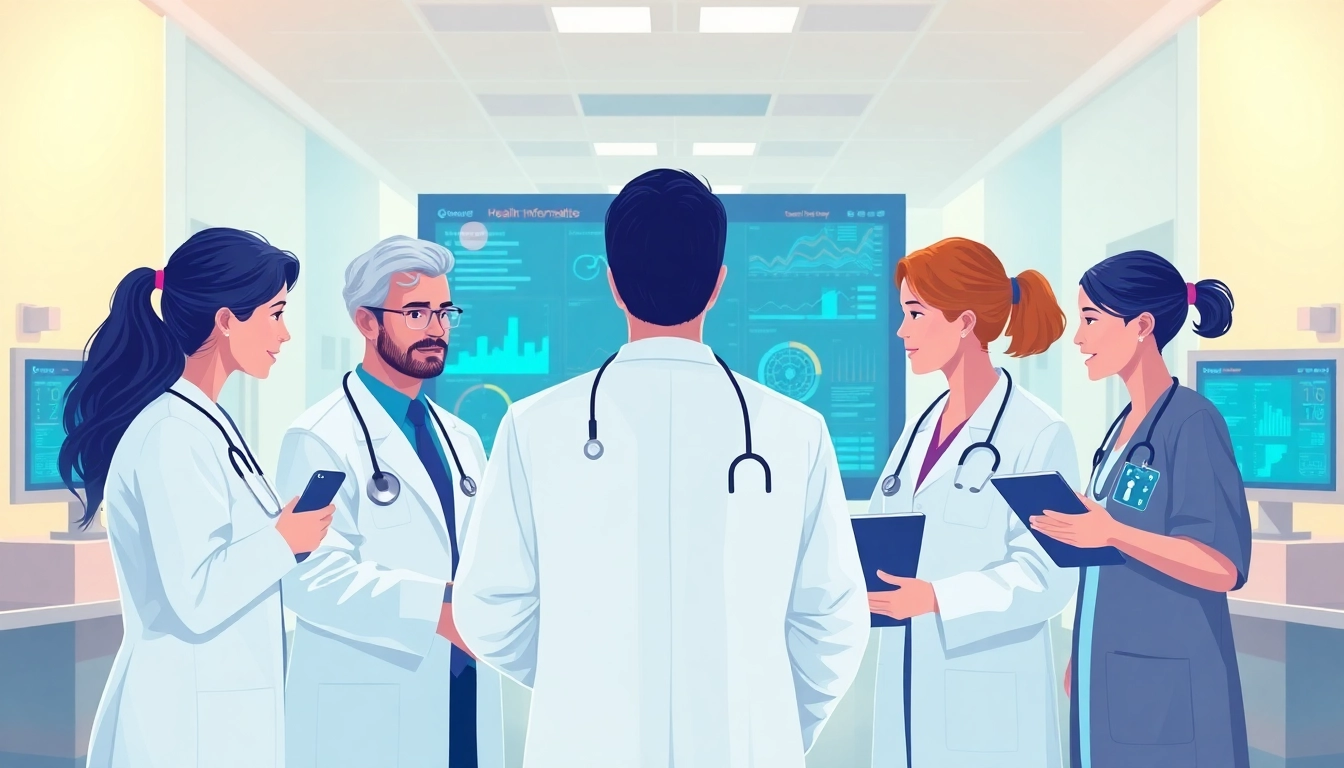
Understanding Health Informatics
Definition and Importance of Health Informatics
Health informatics is an interdisciplinary field that utilizes the principles of information technology and computer science to manage health data and enhance healthcare outcomes. It plays a critical role in improving the efficiency of healthcare delivery, enhancing patient care, and supporting healthcare providers in making informed decisions. As healthcare systems increasingly adopt technology to streamline processes, the significance of health informatics continues to grow.
This domain focuses on how data, information, and knowledge are acquired, processed, and utilized in healthcare settings, ultimately affecting patient outcomes and public health at large. The https://www.informaticsview.com website offers extensive resources for understanding the application of informatics in healthcare, illustrating its transformative potential across various domains.
The importance of health informatics cannot be overstated. It enables healthcare professionals to analyze patient data effectively, thereby facilitating improved decision-making and predictive analytics. Furthermore, it enhances communication among healthcare stakeholders, which is crucial for ensuring continuity of care and promoting better health outcomes.
Key Components of Health Informatics Systems
Health informatics systems comprise several essential components that work synergistically to enable comprehensive healthcare solutions. These components include:
- Electronic Health Records (EHRs): Digital versions of patients’ paper charts. EHRs are real-time, patient-centered records that make information available instantly and securely to authorized users.
- Health Information Exchange (HIE): A technology that allows healthcare organizations to share patient information electronically, facilitating better care coordination.
- Clinical Decision Support Systems (CDSS): Tools that provide health professionals with knowledge and person-specific information, intelligently filtered, and presented at appropriate times, to enhance health and healthcare.
- Telemedicine: The use of telecommunications technology to deliver medical services and information from one location to another, crucial for remote patient management and access.
- Health Analytics: The use of data analysis techniques to discover patterns and insights from health data, aiding in improving health outcomes and operational efficiency.
Integrating these components effectively leads to a robust health informatics ecosystem that not only supports clinical workflows but also optimizes patient care.
Current Trends in Health Informatics
As technology evolves, so does the field of health informatics. Notable trends include:
- Artificial Intelligence and Machine Learning: These technologies enable predictive analytics and personalized medicine by analyzing vast amounts of data for patterns and insights in patient care.
- Interoperability: Enhanced connectivity between different health information systems allows seamless data sharing and improves care coordination.
- Patient Engagement Technologies: Tools that allow patients to access their health records, communicate with health professionals, and manage their health more proactively.
- Wearable Health Technology: Devices that monitor health metrics in real-time, offering patients and providers timely data that can lead to better health decisions.
These trends represent just a fraction of the dynamic landscape of health informatics, which is poised to continue evolving as new technologies emerge.
Implementing Health Informatics Solutions
Steps for Effective Implementation
Implementing health informatics solutions requires careful planning and execution. Organizations can follow these key steps:
- Needs Assessment: Evaluate existing systems and identify gaps and the specific needs of stakeholders.
- Stakeholder Engagement: Involve all key stakeholders—including healthcare providers, administrative staff, and patients—in the planning process to ensure buy-in.
- System Selection: Based on needs assessment and stakeholder input, select a health informatics system that aligns with the organization’s goals.
- Implementation Planning: Create a detailed implementation plan, outlining timelines, resources needed, and training requirements.
- Training and Support: Provide comprehensive training for all users of the system to ensure effective utilization.
- Evaluation and Feedback: After implementation, continuously assess the effectiveness of the system and gather feedback to make necessary adjustments.
Following these steps can help healthcare organizations implement health informatics solutions effectively and sustainably.
Overcoming Common Challenges
Despite the benefits of health informatics, organizations often face challenges during implementation. Key challenges include:
- Resistance to Change: Many staff may be accustomed to traditional workflows. Engaging them during the planning phase can help mitigate resistance.
- Data Privacy Concerns: Ensuring compliance with regulations such as HIPAA is crucial to maintaining patient trust and data integrity.
- Lack of Interoperability: Systems that do not communicate effectively can lead to fragmented patient care. Choosing systems that prioritize interoperability is essential.
- Funding and Resources: Limited budgets can restrict technology adoption. Organizations need to develop robust business cases for investments in informatics solutions.
Addressing these common challenges proactively can pave the way for successful health informatics initiatives.
Case Studies of Successful Implementations
Examining successful health informatics implementations offers valuable insights. For instance:
- Mount Sinai Health System: Implemented an integrated EHR system that improved coordination among specialists and reduced medication errors significantly.
- Intermountain Healthcare: Leveraged data analytics to identify high-risk patients, leading to targeted interventions that improved patient outcomes.
These case studies underscore the transformative potential of health informatics when executed effectively.
Evaluating Health Informatics Impact
Metrics for Success in Health Informatics
Quantifying the impact of health informatics is crucial for justifying investments. Key metrics include:
- Patient Outcomes: Improvements in health metrics such as reduced hospital readmission rates and enhanced clinical outcomes.
- Operational Efficiency: Metrics like reduced waiting times, increased patient throughput, and improved staff productivity.
- Patient Satisfaction: Surveys and patient feedback can gauge satisfaction and engagement with the health informatics system.
These metrics provide valuable insight into the effectiveness of health informatics initiatives.
Tools for Measuring Effectiveness
Several tools can assist in measuring the impact of health informatics implementations:
- Data Analytics Software: Tools that help process and analyze health data to extract actionable insights.
- Dashboards: Visual representations of key performance indicators (KPIs) that facilitate real-time monitoring of health informatics systems.
- Patient Feedback Tools: Online surveys and platforms that capture patient experiences and satisfaction levels.
Utilizing a combination of these tools can enhance the accuracy of performance measurement in health informatics.
Feedback Mechanisms for Improvement
Creating robust feedback mechanisms is essential for continuous improvement in health informatics:
- Regular Staff Training: Keeping staff updated on new features and gathering feedback on their experiences.
- Patient Engagement: Actively soliciting patient feedback to understand their experiences, preferences, and outcomes.
- Iterative System Updates: Utilizing feedback for iterative updates to informatics systems to better meet user needs.
These mechanisms ensure that health informatics systems evolve in response to the needs of their users.
Future of Health Informatics
Emerging Technologies to Watch
The future of health informatics is being shaped by several emerging technologies:
- Blockchain: Promising enhanced security and interoperability in health data management.
- Telehealth Advancements: Continued growth in telehealth services will expand access to care, particularly in underserved areas.
- Genomics: Integration of genomics data into health informatics systems to provide personalized health insights.
Monitoring these trends can help health professionals anticipate changes in the informatics landscape.
The Role of AI in Health Informatics
Artificial intelligence is set to revolutionize health informatics. Its applications may include:
- Predictive Analytics: Identifying at-risk patients before conditions become critical through data modeling.
- Automated Process Flows: Improving efficiency by automating repetitive tasks, thus allowing healthcare providers more time to focus on patient care.
- Natural Language Processing: Enhancing data entry by allowing healthcare professionals to dictate notes and convert them into structured data.
AI’s integration into health informatics will likely lead to substantial improvements in how healthcare systems operate and respond to patient needs.
Future Skill Sets for Health Informatics Professionals
The evolving field of health informatics necessitates that professionals develop new skill sets, including:
- Data Analysis: The ability to analyze and interpret complex health data to facilitate informed decision-making.
- Interpersonal Skills: Effective communication and collaboration skills are essential for working within multidisciplinary teams.
- Technical Proficiency: Familiarity with emerging technologies and platforms in health informatics, including EHR and telehealth systems.
As the field matures, ongoing professional development will be crucial for adapting to new challenges and opportunities.
Career Opportunities in Health Informatics
Job Roles and Responsibilities
The field of health informatics offers a variety of career opportunities. Key roles include:
- Health Informatics Specialist: Focuses on the implementation and optimization of health information systems.
- Clinical Data Analyst: Analyzes patient data to improve clinical outcomes and operational efficiency.
- Health IT Consultant: Advises healthcare organizations on the strategic use of technology to enhance healthcare delivery.
The diversity of roles illustrates the broad scope and significance of health informatics in the healthcare sector.
Skills Required for a Career in Health Informatics
To succeed in health informatics, professionals should develop a blend of technical and interpersonal skills, including:
- Technical Skills: Knowledge of health IT systems, data management, and health analytics tools.
- Problem-Solving Abilities: Critical thinking skills to troubleshoot issues and develop innovative solutions.
- Communication Skills: Effectively conveying complex technical information to non-technical stakeholders.
These skills will prepare individuals to navigate the challenges of health informatics effectively.
Resources for Professional Development
Continued learning and professional development are vital in this fast-evolving field. Recommended resources include:
- Professional Organizations: Joining groups such as the American Medical Informatics Association (AMIA) can provide networking opportunities and access to professional development resources.
- Online Courses: Many institutions offer online courses and certifications in health informatics, allowing professionals to enhance their skills from anywhere.
- Conferences and Workshops: Attending industry conferences enables networking with peers and learning about the latest trends and technologies.
These resources will help navigate the career landscape in health informatics successfully.








